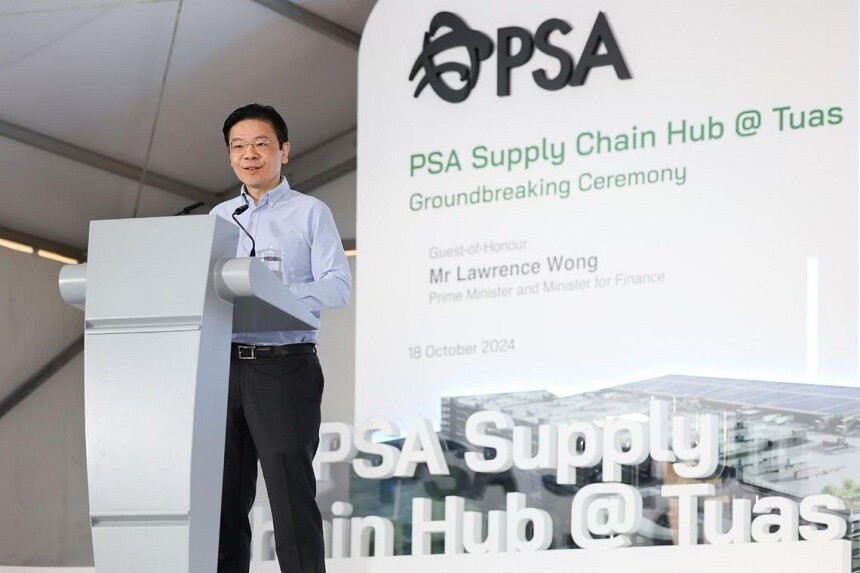
PSA breaks ground on new $647.5m supply chain hub, in efforts to keep Tuas Port competitive
SINGAPORE : Port operator PSA broke ground on a new $647.5 million Tuas warehousing facility equipped with advanced robotics and automation systems on Oct 18, as part of its efforts to sharpen Tuas Port’s competitive edge.
Construction of the new facility comes as Singapore looks set to handle a record-breaking container volume of 40 million 20-foot equivalent units (TEUs) in 2024.
Spanning more than 185,000 sq m and located within the limits of Singapore’s new mega port, the new PSA supply chain hub is expected to be completed in the second quarter of 2027.
Speaking at an event to officially mark the start of construction work, Prime Minister Lawrence Wong said the hub will improve the Republic’s ability to handle cargo shipments.
PM Wong, who is also Finance Minister, said the new hub will have facilities to handle dangerous goods, as well as goods that require cold storage. This will allow it to process higher-value cargo, such as pharmaceuticals and chemicals that require special handling.
“Currently, businesses that want such services have to truck their cargo out of the port, incurring duties, and then truck it back to the port for shipping again. This takes time, and it adds up to additional costs,” he said. With the new supply chain hub, companies will be able to tap these specialised cargo handling services under one roof within the same free trade zone as Tuas Port, he noted. Custom duties are not charged on goods that are stored in such free trade zones.
“We want businesses to use Tuas Port as a convenient and efficient one-stop shop, not only for their physical goods but also as a control tower to manage their inventory and global supply chain flows,” PM Wong added.
Construction of the facility comes as competition gets increasingly sharp in the shipping industry.
PM Wong said other major ports like Shanghai and Rotterdam were upgrading their infrastructure to serve larger vessels and attract “mega” shipping alliances.
He added that many ports around the world are also offering services beyond just moving containers. These include cold storage facilities and regional distribution centres.
Furthermore, unlike ports in countries with large production and consumption bases, Singapore has no hinterland of its own, he added.
In this environment, Singapore cannot afford to be complacent and has to sharpen its competitive edge to remain the “preferred port of call”, PM Wong said.
“We must continually invest not just in the Port of Singapore but also in value-added capabilities so that we can keep on adapting and staying abreast of changing trends.”
These trends include the growing scale of shipping, with ships today built to carry up to 25,000 containers, compared with 500 to 800 containers in the 1950s, he said.
Shipping alliances, which allow major container shipping lines to share vessels, port calls and trade routes, are also growing bigger, he said.
What this means is that ports will need to have the infrastructure to handle large ships and large numbers of containers efficiently. Ports will also need to add value to shipping alliances to attract the large fleets they operate.
“The major alliances today hold over 80 per cent of the world’s container shipping capacity. Changes in their service networks could significantly affect traffic to hubs like Singapore,” PM Wong added.
Singapore’s port terminals handled a record 39 million TEUs in 2023 and hope to cross 40 million TEUs in 2024, he said. Vessel arrivals and bunker volumes have also risen in the first nine months of the year.
The completion of PSA’s new supply chain hub in Tuas in 2027 will coincide with the closure of Keppel Distripark, which specialises in the consolidation and distribution of cargo.
PM Wong said the new hub will expand the capacity currently available at Keppel Distripark, allowing Singapore to attract more trade.
He added that there will also be “many more developments” in the coming years to ensure Tuas Port can continue to serve the largest container vessels.
On its part, the Government will also help to ensure cargo and vessels move on time and on schedule.
For instance, the Maritime and Port Authority of Singapore is developing new systems to improve navigational safety and operational efficiency in the Singapore Strait and the Republic’s port waters, Mr Wong said.
“We will have improved abilities to anticipate potential disruptions and hazards, and to manage incidents,” he added.
In a statement on Oct 18, PSA said the construction of the new supply chain hub is a central part of its strategy to expand within Tuas Port.
PSA International Group Chief Executive Officer Ong Kim Pong said rapidly evolving global trade patterns require the port operator to rethink its business strategy.
The new supply chain hub in Tuas will allow the company to harness the full potential of its port and logistics network, which PSA will continue to expand in a “sustainable way”, he added.
Tuas Port, which is being developed in four phases, will be able to handle 65 million 20-foot containers when fully operational in the 2040s, making it the world’s largest automated port.
As at October, 10 of its 66 container berths are in operation, with one more berth expected to begin operations by end-2024.
By 2027, operations at Tanjong Pagar, Keppel, and Brani terminals will be shifted to the $20 billion mega port. Meanwhile, Pasir Panjang terminal will remain open until its operations are also consolidated in Tuas by the 2040s.
